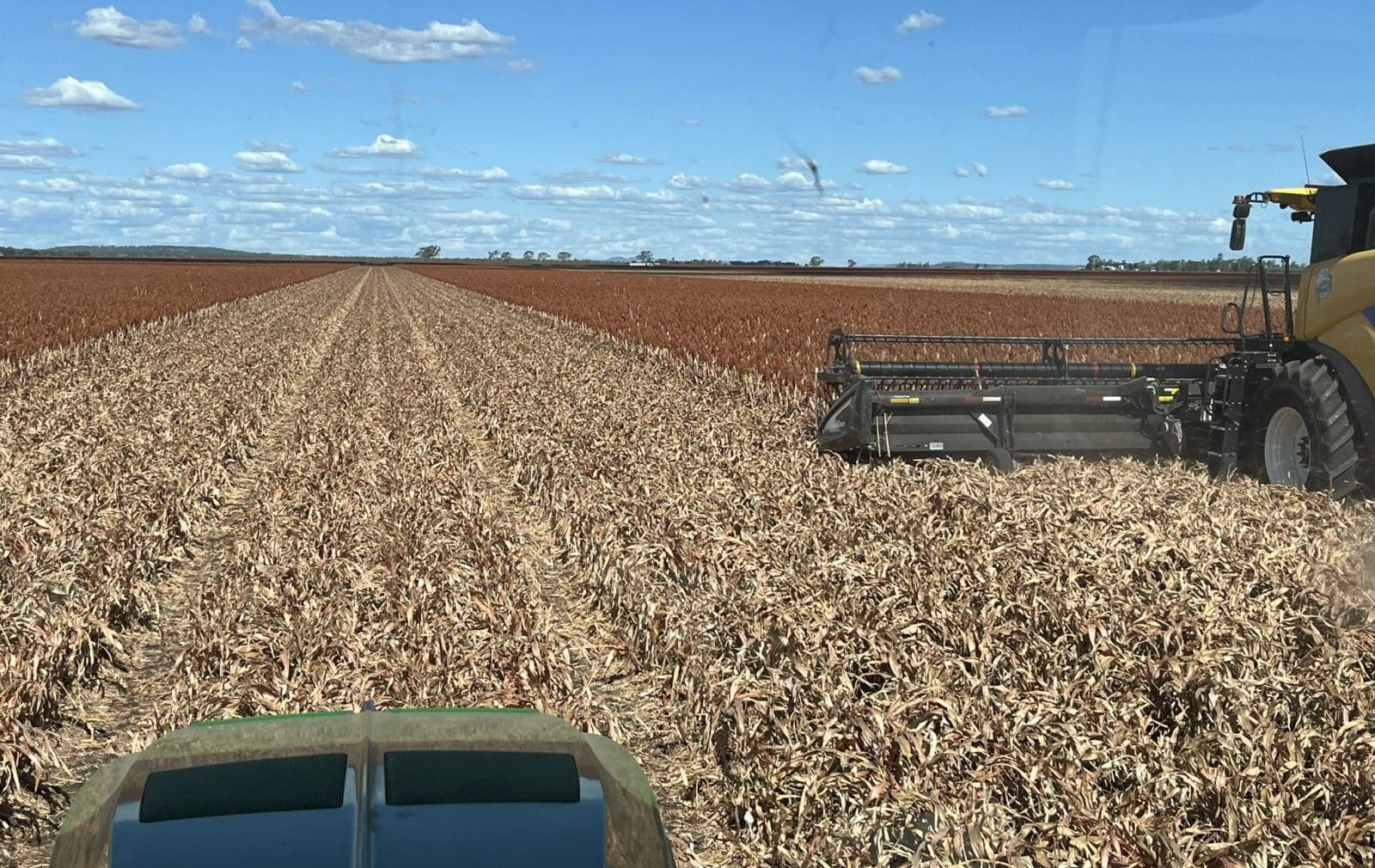
Sorghum harvesting south of Jondaryan on the Darling Downs last week. Photo: Peter Waddell
NORTHERN wheat and barley values have jumped in the past week in response to a firming international market and rising bids from consumers needing to extend coverage.
In the south, markets have firmed a little, and dry conditions in much of Victoria and South Australia have lifted demand for supplementary feed, which is making mixed farmers tighten their grip on on-farm stocks.
| Feb 13 | Feb 20 | |
| Barley Downs | $318 | $330 |
| ASW Downs | $335 | $355 |
| Sorghum Downs | $322 | $322 |
| Barley Melbourne | $340 | $342 |
| ASW Melbourne | $360 | $362 |
Table 1: Indicative prices in Australian dollars per tonne.
North jumps
An increase in export volumes of milling wheat, and firmer international values, have seen prices for ASW-type wheat increase by $10-$15 per tonne in the past week in the Brisbane port zone.
The rally has brought some consumers into the market to book coverage on concerns that the market will firm further, and that wheat exports out of Queensland will accelerate.
“Delivered bids for ASW or SFW are being executed out of northern New South Wales,” one trader said of the Downs market.
The bulk chickpea program is still drawing truckloads of the pulse from farms in northern NSW and southern Qld, and a small window for wheat has emerged between the end of chickpeas and the start of sorghum.
“We’re not executing big volumes of wheat, but it’s making a difference.”
“There are a few trade shorts around.”
Small volumes of warehoused wheat and barley are coming out of depots to supply those consumers not covered, partly or fully, for the coming quarter.
At Goondiwindi, Goldstar Commodities director Marn Wood said both grower selling and end-user coverage have stepped up recently, and growers were waiting to see how the autumn break panned out.
“If they get planted on good rain, they’ll sell; if it’s dry, they’ll hold,” Ms Wood said.
With free warehousing available to growers until the end of the financial year, Ms Wood said growers could hold out until June to sell depot grain.
“What happens in the next month with the weather will influence that.”
On cottonseed, Woodside Commodities managing director Hamish Steele-Park said current-crop is trading in limited volume due to a lack of offers, and demand being confined to the domestic market.
Prompt values are around $410/t ex Gwydir Valley, and $460/t delivered Downs, with ex gin southern NSW at $450/t.
“New-crop values are a tad firmer over the past week or so, with some China demand, plus support from domestic inquiry,” Mr Steele-Park said.
“There’s a lack of offers on new crop, and I would say growers are behind on forward sales compared to previous years.”
Mr Steele-Park said gins were busy trying to clean seed out of sheds before new-crop hits in 6-8 weeks or so.
New-crop markets for April onwards are sitting at around $390/t ex Gwydir Valley, $405/t in southern NSW, and $440/t delivered Downs.
South firms
The southern market also has a firmer tone this week as some competition emerges between consumers and exporters for the limited volume of grain growers have been offering up.
GeoCommodities broker Brad Knight said global values “sneaking up” have brought buyers and sellers to the market.
“We’ve been slower to respond after several weeks of values slightly improving,” Mr Knight said.
In South Australia, Advantage Grain state manager David Long said SA cereal values have risen $20-$25/t over the past two months amid minimal selling from growers after the smallest SA harvest in many years.
“A lot of farmers have kept wheat and barley on farm for their own use,” Mr Long said.
“Anyone with livestock kept a lot of grain, due to the fact that they caught last year by needing to buy some in to feed out to livestock.”
Helping a little to offset the pain of a low-yielding harvest has been generally good quality, with many SA growers getting Hard wheat for crops in the bin ahead of some patchy falls mid-harvest.
Any SFW and ASW-type wheat harvested post rain has largely been held on farm to feed to livestock, and weather-damaged faba beans have also been retained.
While Vic, SA and southern NSW are usually dry at this time of year, fallows and pastures often got a boost from storm rain, which has been limited this summer, and excessive heat and wind have further dried the profile.
Mr Long puts is clearly: “There’s no subsoil moisture”.
Grain Central: Get our free news straight to your inbox – Click here


HAVE YOUR SAY